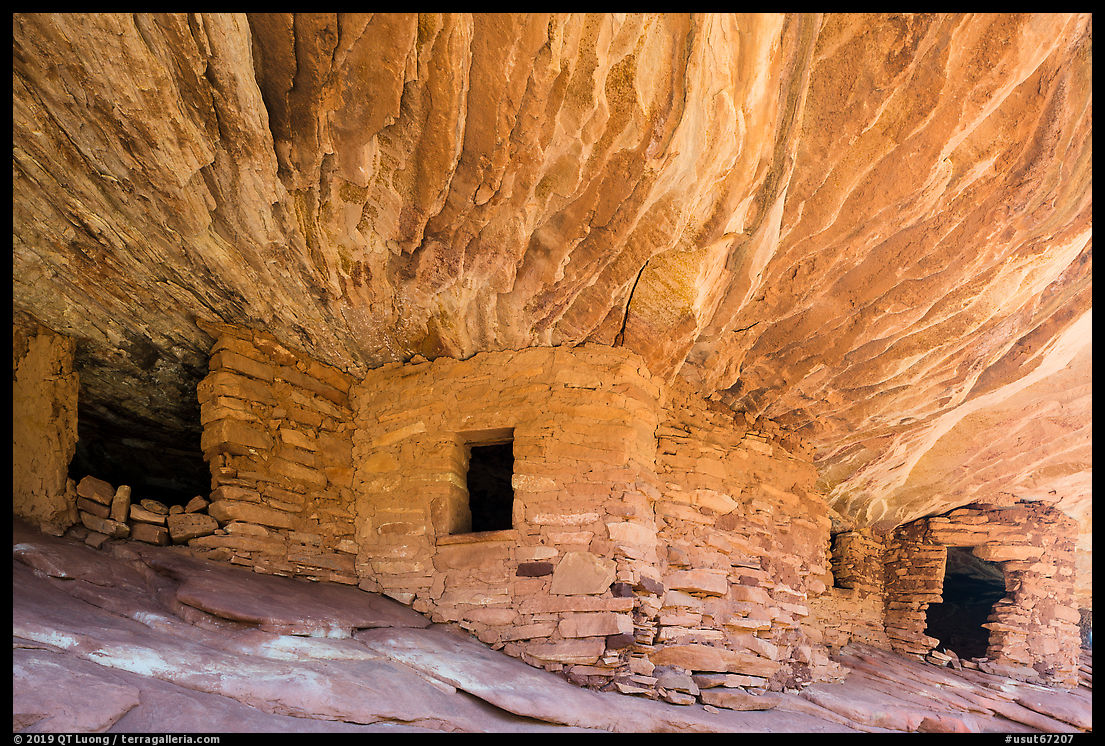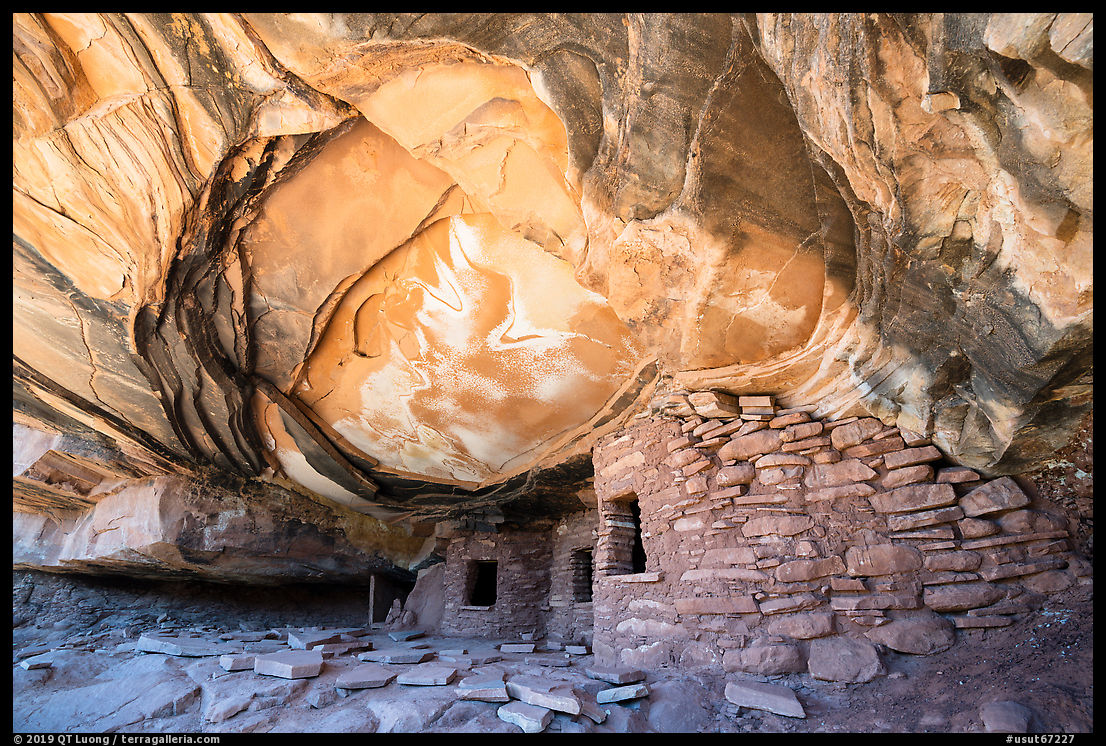Two iconic ruins in Bears Ears National Monument
6 Comments
Mesa Verde and Chaco Canyon have the most famous massive multi-room Ancestral Puebloan ruins in the Southwest. However, when it comes to smaller structures, in addition to harboring the highest concentration of them anywhere, Bears Ears National Monument’s Cedar Mesa area is home to possibly the two most iconic of them: House of Fire and Fallen Roof Ruin.
One of the main things that draw me to those ancient structures is how they harmonize with their natural environment (read about the landscapes of Bears Ears). Although both structures are well-preserved, what makes each of them distinctive and iconic is the roof of the rock alcove in which they are built, rather than the building itself. The trailheads are a 45 minute drive from each other so that a half-day visit to both would be possible, however, I do not recommend it since the optimal time to photograph is about the same, and you cannot be at both places at the same time. The two structures face west. In the early morning or late afternoon, they are in the shade, without reflected light, which makes the light flat and dull. In the afternoon, the sun reaches them partly, creating extreme contrast at unwanted spots. It is only from the mid to late morning that sunlight reaches in the canyon close enough without shining directly on the structure, casting a soft and warm glow into the alcoves. Reflected light is the main ingredient for many of the great compositions on the Colorado Plateau. The similarities stop there, though, as otherwise my experience was quite different.
House on Fire
House on Fire ruin is the most popular and easy to access of the two. Like many other classic compositions, it was popularized by the great photographer David Muench, and is now the most photographed in Cedar Mesa. The ruin, located in Mule Canyon, is included in the reduced boundaries of Bears Ears National Monument. The trailhead is just 0.3 miles off UT-95 (19.5 miles west from US-191, 9 miles east from UT-261), and after a straightforward 20 minutes hike in the shallow canyon, the structure is found about 25 feet above the canyon floor on your right . When I was there, there were many cars at the trailhead, and many hikers on the trail. Some did not seem to realize what makes House on Fire special until I suggested that they stand in the shade and look at the alcove’s roof, that evokes flames, or alternatively Cirrus fibratus clouds.

A

B

C
Fallen Roof Ruin
Fallen Roof Ruin is as iconic but less popular, probably because access requires a bit more effort. For the entire duration of my visit, since leaving the pavement, I didn’t see any other person. The trailhead, which is much smaller, requires traveling 3.5 miles on the unpaved Cigarette Springs Road (13 miles south of the intersection of UT-261/UT-95). In November, I was able to drive my Prius, but I could imagine the road becoming difficult to pass in wet weather. The hike is not much longer, but more complicated. You first hike on the top of a forested mesa before dropping into a larger canyon. Laurent Martres described a route via a secondary canyon, but since his visit, the main trail appears to continue further on the mesa and drop directly into the main canyon, which is quite large and deep. It is not obvious to identify the landmarks referred to in the descriptions, and the structure is quite high, maybe 150 feet, above the canyon floor. It took me a while to spot it since it was in the shade .The Fallen Roof Ruin is not included in the new proposed boundaries of Bears Ears National Monument. I have described in a previous post some of the lands stripped of protections in Bears Ears National Monument. From an archeological point of view, the crown jewel of Bears Ears was clearly Cedar Mesa, including Grand Gulch, which had the densest population in North America before the arrival of non-native settlers. Almost all of Cedar Mesa was excluded from the new boundaries. Although the most iconic of them is the Fallen Roof Ruin, it is a place where you can find cliff dwellings and other structures around each corner.

1

2

3

4

5
Both ruins allow for multiple compositions. Even from an almost identical viewpoint, like in those images of the Fallen Roof Ruin, how much of the alcove’s roof is included changes the image quite a bit. I’d appreciate it if you would let me know which ones you prefer, and maybe why. If you don’t see the window below, click here.


I think B on House on Fire because it shows all of the openings so well and represents how I saw it in person. On Fallen Roof, the second (2) shows the wall structure of the ruin and the fallen roof so well.
A-fully expresses the flames of the fire.
3-provides the strongest feeling of the sagging roof structure and shows more ready to drop at any time.
House on Fire – I have dozens and dozens of my own photos here, and have pored over them. I already have a favorite composition, and B is close to it. Seeing the greater width of the structure, and all four openings is nice, and the balance of foreground, structure, and roof flame is pleasing.
Fallen Roof – B is the strongest graphically, and draws me in. I prefer it (marginally) over the others for the many dark layers rising up the left side. I would have preferred some front rise on it to correct the perspective, but I still like it best. A would be my runner-up.
Thanks for sharing this.
Thanks for the comment. Fallen Roof B was made with an extreme wide-angle lens (16mm). I don’t think there is even a lens that wide covering 5×7 with movements, although the Canon 17 TSE, which I don’t have comes close in digital. To be able to apply perspective correction in post-processing, I would also have had to shoot a composite pano since the widest lens I own is a 15mm and applying perspective correction requires extra cropping room. The three last images were photographed with a 24mm TSE lens.
Another very nice ruin that now falls out of the Monument boundaries is the Moon House.
https://alanmcconnellphoto.photoshelter.com/gallery-image/The-Enchanting-Southwest/G0000o7Qff5nEbBM/I00002EB8usY_B0U
Thanks for sharing. So many ruins were excluded!